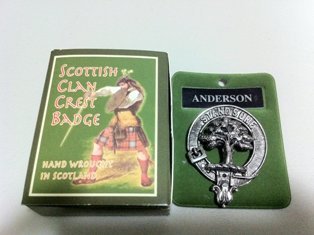Don Juan (John) Anderson & Josefa de la Cruz
Bernard T. Punzalan
March 8, 2013
 My fore-father, John Anderson, was born in Edinburgh, Scotland. He came to Guam on March 18, 1819 via the French Corvette L’Uranie, commanded by Louis de Freycinet. John temporarily served as the Chief Quartermaster on the L’Uranie, and was allowed to remain in Guam at his own request. [1]
My fore-father, John Anderson, was born in Edinburgh, Scotland. He came to Guam on March 18, 1819 via the French Corvette L’Uranie, commanded by Louis de Freycinet. John temporarily served as the Chief Quartermaster on the L’Uranie, and was allowed to remain in Guam at his own request. [1]
Sometime later that year John met Josefa de la Cruz. Josefa was born in Agaña, Guam. On November 21, 1819, John and Josefa were married by Father Ciraco del Espiritu Santo in Agaña, Guam. During the wedding ceremony Cadet Manuel Torres was the padrino (best man) and the madrina (maid of honor) was Andrea Palomo. It also appears that it is from this point in time, where John Anderson now becomes known as Juan Anderson[2].
According to Lieutenant William Safford (1905), in May 1828, Dumont D’Urville, commander of the Astrolabe, visited Guam and described John “as a fine looking man, well behaved, and speaking French pretty well.” “Anderson knew Quoy and Gaimard, having been shipmates with them on the Uranie. As Captain of the Port, he came to investigate the sickness on board, fearing that some contagious disease might be introduced into the island. He gave D’Urville information regarding the hydrography of the region.”
On October 8, 1831, Don Francisco Villalobos, Governor of the Mariana Islands appointed John as the Port’s Adjutant with a salary of four pesos ($4.00) a month. The appointment also authorized John to act with full authority in the absence of the Port’s Captain and further granted him the title of “Don.”
In consideration of John’s merits since his appointment as the Port’s Adjutant, Governor Villalobos soon commissioned John as a Second Lieutenant of the Maritime Militia on January 18, 1832. This commissioning included the appointment as the Superintendent of the Maritime Battalion, a newly created department in the Mariana Islands.
Dr. John Wilson (1991), a physician from a visiting whaling ship in 1840, wrote that “John Anderson was a Lieutenant in the English Navy. He was found guilty of a breach of trust and fled to the Marianas where he established his residence and married a local woman. He was a tall very stout man, fluent in Spanish, Chamorro, and French; he was the government pilot, interpreter, port-adjutant and he was responsible for other functions.”
Paul Souder (1978) writes:
In 1848, Governor Don Pablo Perez forwarded a petition of John Anderson asking that he be paid a salary for his services as interpreter and translator of English and French when the government required such service. Anderson was Aide to the Captain of the Port, with the approval of the Superior Government and the Commandant General of the Navy dated July 20, 1831, as attested by orders certified by Governor Villalobos. He acted as pilot for bringing ships into and out of the harbor, and received a fee of 10 pesos per year from the Navy fund. “He was attentive to his duties, and his conduct was good, except when there was a reunion of his fellow countrymen, Captains of ships arriving at this port—on which occasion, like a good Englishman, he got drunk; but apart from this there was nothing to be said against him. He had no permit of naturalization.”
An extract from the log of the “Emily Morgan” of New Bedford, Massachusetts, Captain Ewer commanding (1849-1854) gives a most interesting account in Captain Anderson’s own words of an attempt to take over the island several years before. “The Captain and a few more English residents contrived a plan to make themselves possessors of the island. They secretly worked, step by step, at the same time insinuating themselves into the graces of the Governor. Their plans worked to a charm, and when they were fully matured, they quietly took possession of the Palace, the Governor having been made, as Captain Anderson expressed it, “as drunk as a boiled owl.” As they now had possession of all the arms and ammunition, it was an easy matter to subdue the natives, which they did in short order, without loss of life on either side, covering themselves with glory. As matter of course, the new lords and masters must have a glorious jollification over the affair, and at the same time agree on a governor. This latter, however, proved no easy task, as all were equally anxious to “serve their country” in being the chief dignitary of the island. After consulting and debating some hours, and finding they were no nearer a decision than at first, they decided to have a spree, and whoever should remain sober the longest, and see the others all laid out, should be the honorable governor. Accordingly at it they went, bottle after bottle disappeared, one by one they voluntarily relinquished their seats and quietly rolled under the table. After a short time on one remained in his seat but Captain Anderson, and he feeling elated at his success, drank a few bumpers to Captain Anderson, the future Governor of the distinguished Island of Guam. But, as he said, “he was born under an unlucky star.” So it proved, as the bumpers he drank to his own good health keeled him over, and he took his place among his comrades. The Spaniards, who had been watching these proceedings with no small degree of interest, seeing how matters stood and the would-be Governors gloriously drunk, very adroitly bound them hand and food. The dethroned governor was of course, immediately reinstated, and the next day these noble spirits were arraigned for trail. Being convicted of treason, they were sentenced to be placed on a raft, taken out to sea and then cast loose, leaving them at the mercy of the winds and waves. This was accordingly done, and after drifting about several days, they were safely landed on the island of Tinian. Here they resided some time, finally expressing their sorrow for what they had done, the governor pardoned them, and permitted them to make Guam their future residence, on swearing allegiance to the government and promising to be true and loyal citizens.
According to Wilson (1991), Juan and Josefa had eleven children: six boys and five girls. However, I have been able to only account for six of the eleven children[3]:
- Dona Maria, who married Don Andres de Castro;
- Dona Dolores, who married Don Felix Olivares Calvo;
- Don Jose (Familian Che’), who married Ramona Quitugua;
- Don Juan, who married Dona Maria de Castro;
- Dona Josefa Engracia[4], who married Don Francisco Tudela[5]; and,
- Dona Rosa who married Don Felix Roberto.
- Unnamed boy operated on for Phymosis and described by Dr. Wilson (1991) as a complete cripple & emaciated by extensive ulcers on his hands and legs.
[Sidebar...the images appended to this article is a list of foreigners in the Marianas compiled on October 22, 1829 by Don Juan Anderson. Copies were provided by Herman "Junpan" Tenorio Guerrero.]
Bibliography
Brunal-Perry, Omaira. 2012. 19th Century Society in Agaña: Don Francisco Tudela, 1805-1856, Sargento Mayor of the Mariana Islands’ Garrison, 1841-1847, Retired on Guam, 1848-1856 (presented at the 1st Marianas History Conference). Mangilao, Guam: Micronesia Area Research Center
Rogers, Robert F. 1995. Destiny’s Landfall: A History of Guam. Hawaii: University of Hawaii Press
Safford, William E. 1905. The Useful Plants of the Island Guam. Washington DC: Government Printing Office
Souder, Paul B. 1978. Heritage: A geneology of the Souder-Torres and affiliated families throughout the nineteenth and twentieth centuries. Guam
Spanish Government. 1897. Padrón de almas (from the Library of Congress).
Wilson, John. 1991. The Cruise of the Gipsy: The Journal of John Wilson, Surgeon of a Whaling Voyage to the Pacific Ocean 1839-1843. Fairfield, Washington: Ye Galleon Press
[1] Paul Souder (1978) had the most extensive research and write-up on Don Juan Anderson and Josefa de la Cruz, which much of this document is derived. This document pretty much serves as an update to his work.
[2] Omaira Brunal-Perry (2012) has certainly been instrumental with some of the updated information contained in this document.
[3] Based on the 1897 Padrón de almas, Maria (widow, age 74) and Josefa (widow, age 73) appear to be the only recorded children of Juan and Josefa in those census records

